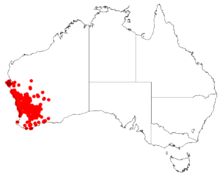Podotheca gnaphalioides
Podotheca gnaphalioides (common name, golden long-heads) is a small annual herb in the family Asteraceae, endemic to Western Australia.[4] It grows from 2 cm to 60 cm tall and is an often sticky herb, which is erect or decumbent (lying along the ground), and whose yellow or orange-yellow flowers are seen from August to November. It grows on a variety of soils, but tends to prefer sandy soils.[4]
| Podotheca gnaphalioides | |
|---|---|
 | |
| Scientific classification | |
| Kingdom: | Plantae |
| Clade: | Tracheophytes |
| Clade: | Angiosperms |
| Clade: | Eudicots |
| Clade: | Asterids |
| Order: | Asterales |
| Family: | Asteraceae |
| Genus: | Podotheca |
| Species: | P. gnaphalioides |
| Binomial name | |
| Podotheca gnaphalioides | |
 | |
| Occurrence data from AVH | |
| Synonyms[3] | |
|
Lophoclinium citrinum Endl. | |
Taxonomy
It was first described in 1845 by Robert Graham as Podotheca gnaphalioides.[2][1]
gollark: Er, sure, I'll pull up the incident report system docs.
gollark: Can you connect it to potatOS Analytics too?
gollark: * received it
gollark: Make the data come with information on who sent it.
gollark: Meanwhile, I'm pretty sure DuckDNS is *up*!
References
- Graham, R. (1841) Edinburgh New Philosophical Journal 31(62): 394.
- "Podotheca gnaphalioides". Australian Plant Name Index (APNI), IBIS database. Centre for Plant Biodiversity Research, Australian Government. Retrieved 24 January 2019.
- Govaerts, R. et. al. (2019) Plants of the world online: Podotheca gnaphalioides. Board of Trustees of the Royal Botanic Gardens, Kew. Retrieved 25 January 2019.
- "Podotheca gnaphalioides". FloraBase. Western Australian Government Department of Parks and Wildlife. Retrieved 24 January 2019.
This article is issued from Wikipedia. The text is licensed under Creative Commons - Attribution - Sharealike. Additional terms may apply for the media files.